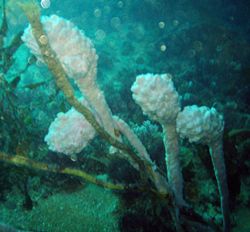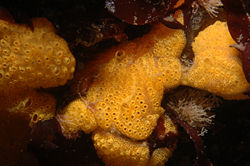Tunicate
| Tunicates Fossil range: Early Cambrian - Recent |
||||||
|---|---|---|---|---|---|---|
 Sea Tulips, Pyura spinifera
|
||||||
| Scientific classification | ||||||
|
||||||
| Classes | ||||||
|
Ascidiacea (2,300 species) |
Tunicate, also known as urochordata, tunicata (and by the common names of urochordates, sea squirts, and sea pork[1]) is the subphylum of a group of underwater saclike filter feeders with incurrent and excurrent siphons, that are members of the phylum Chordata. Most tunicates feed by filtering sea water through pharyngeal slits, but some are sub-marine predators such as the Megalodicopia hians. Like other chordates, tunicates have a notochord during their early development, but lack myomeric segmentation throughout the body and tail as adults. Tunicates lack the kidney-like metanephridial organs, and the original coelom body-cavity develops into a pericardial cavity and gonads. Except for the pharynx, heart and gonads, the organs are enclosed in a membrane called an epicardium, which is surrounded by the jelly-like mesenchyme. Tunicates begin life in a mobile larval stage that resembles a tadpole, later developing into a barrel-like, sedentary adult form.
While most tunicates live on the ocean floor, salps, doliolids, and pyrosomes live above in the pelagic zone as adults.
Contents |
Life cycle
Most tunicates are hermaphrodites. The eggs are kept inside their body until they hatch, while sperm is released into the water where it fertilizes other individuals when brought in with incoming water.
Some larval forms appear very much like primitive chordates or hemichordates with a notochord (primitive spinal cord). Superficially the larva resemble small tadpoles. Some forms have a calcereous spicule that may be preserved as a fossil. They have appeared from the Jurassic to the present, with one proposed Neoproterozoic form, Yarnemia.
The larval stage ends when the tunicate finds a suitable rock to affix to and cements itself in place. The larval form is not capable of feeding, and is only a dispersal mechanism. Many physical changes occur to the tunicate's body, one of the most interesting being control of movement by the digestion of the cerebral ganglion, which is the equivalent of the human brain in some arthropods and insects. From this comes the common saying that the sea squirt "eats its own brain".[2] In some classes, the adults remain pelagic (swimming or drifting in the open sea), although their larvae undergo similar metamorphoses to a higher or lower degree.
Once grown, adults can develop a thick covering, called a tunic, to protect their barrel-shaped bodies from enemies.
During embryonic development, tunicates exhibit 'determinate cleavage' where the fate of the cells is set early on with reduced cell numbers and genomes that are rapidly evolving. In contrast, the amphioxus and vertebrates show cell determination relatively late in development and cell cleavage is indeterminate. The genome evolution of amphioxus and vertebrates is also relatively slow.[3]
Feeding

Tunicates are suspension feeders. They have two openings in their body cavity: an in-current and an ex-current siphon. The in-current siphon is used to intake food and water, and the ex-current siphon expels waste and water. The tunicate's primary food source is plankton. Plankton gets entangled in the mucus secreted from the endostyle. The tunicate's pharynx is covered by miniature hairs called ciliated cells which allow the consumed plankton to pass down through to the esophagus. Their guts are U-shaped, and their anuses empty directly to the outside environment. Tunicates are also the only animals able to create cellulose.
Tunicate blood is particularly interesting. It contains high concentrations of the transition metal vanadium and vanadium-associated proteins. Some Tunicates can concentrate vanadium up to a level one million times that of the surrounding seawater. Specialized cells can concentrate heavy metals, which are then deposited in the tunic.
Classification
Sea squirts are more closely related to vertebrates (including fish, birds, and humans) than worms, sea stars, or other invertebrates.
The Tunicata contains about 3,000 species, usually divided into the following classes:
- Ascidiacea (Aplousobranchia, Phlebobranchia, and Stolidobranchia)
- Thaliacea (Pyrosomida, Doliolida, and Salpida)
- Appendicularia (Larvacea)
- Sorberacea.
Although the traditional classification is followed for now, newer evidence suggests that the Ascidiacea is an artificial group. The new classification would be:
- Stolidobranchia,
- Phlebobranchia and Thaliacea,
- Aplousobranchia and Appendicularia,
- Sorberacea would belong somewhere in Ascidiacea, or be in a taxon on its own.
The species Ciona intestinalis and Ciona savignyi have attracted interest in biology for developmental studies. Both species' genomes have been sequenced.
Fossil record

Undisputed fossils of tunicates are rare. The best known (and earliest) is Shankouclava shankouense from the Lower Cambrian Maotianshan Shale at Shankou village, Anning, near Kunming (South China).[4] There is also a common bioimmuration of a tunicate (Catellocaula vallata) found in Upper Ordovician bryozoan skeletons of the upper midwestern United States.[5]
There is also two enigmatic species from the Ediacaran period - Ausia fenestrata from the Nama Group of Namibia and a second it is new Ausia-like genus from the Onega Peninsula, White Sea of northern Russia. Results of new study have shown possible affinity of these Ediacaran organisms to the ascidians.[6][7] These two organisms lived in the shallow waters of an sea, slightly more than 555-548 million years ago and are likely the oldest evidence of the chordate lineage of metazoans.[7]
A Precambrian fossil known as Yarnemia has been referred to the Urochordata, however this assignment is doubtful. Complete body fossils of tunicates are rare, but in some tunicate families, microscopic spicules are generated which may be preserved as microfossils. Such spicules have occasionally been described from Jurassic and later rocks. Few paleontologists are familiar with them; tunicate spicules may be mistaken for sponge spicules.
Invasive species
Over the past few years, urochordates (notably of the genera Didemnum and Styela) have been invading coastal waters in many countries, and are spreading quickly. These mat-like organisms can smother other sea life, have very few natural predators, and are causing much concern.[8] They form colonies which are yellowish cream in color, and look like thick sponge-like masses that overgrow themselves on stationary objects on the sea floor such as gravel, mollusc shells, and possibly other encrusting species. These colonies are flexible, irregular, long, flat, and often exist as branched outgrowths projected from the surface. Some of the outgrowths result from the colony encrusting worm tubes or other cylindrical objects but many are solid with a firm gelatinous core. The individuals of the colony are called zooids and many zooids with individual siphonal openings cover the surface of the colony.[9]
Transportation of invasive tunicates is usually in the ballast water or on the hulls of ships. Current research indicates that many tunicates previously thought to be indigenous to Europe and the Americas are, in fact, invaders. Some of these invasions may have occurred centuries or even millennia ago. In some areas, tunicates are proving to be a major threat to aquaculture operations.[10][11]
The U.S. Geological Survey, NOAA Fisheries, and the University of Rhode Island are investigating this phenomenon as they have been spotted in 2004 in Georges Bank. They requested that any information or sightings of these invading colonies be reported to USGS to aid in their investigation.[12]
Medical uses
Tunicates contain a host of potentially useful chemical compounds, including:
- Didemnins, effective against various types of cancer, as antivirals and immunosuppressants
- Aplidine, effective against various types of cancer
- Esteinascidin 743, effective against various types of cancer
In the May 2007 issue of The FASEB Journal, researchers from Stanford University showed that tunicates can correct abnormalities over a series of generations, and they suggest that a similar regenerative process may be possible for humans. The mechanisms underlying the phenomenon may lead to insights about the potential of cells and tissues to be reprogrammed and regenerate compromised human organs. Gerald Weissman, editor-in-chief of the journal, said "This study is a landmark in regenerative medicine; the Stanford group has accomplished the biological equivalent of turning a sow's ear into a silk purse and back again."[13]
References
- Dennis. 2003. pers. comm. Marine Science Dept. Orange Coast College.
- Solomon, E., L. Berg, D. Martin. 2002. Biology. Brooks/Cole.
- ↑ "Gulf Specimen Marine Laboratory: Sea Squirts and Sea Pork". Retrieved on 2007-12-10.
- ↑ Brainless Fish in Topless Bar - Fast Company
- ↑ Holland, Linda Z. "Developmental biology: A chordate with a difference." Nature 447.1 (2007): 153-55.
- ↑ Jun-Yuan Chen, Di-Ying Huang, Qing-Qing Peng, Hui-Mei Chi, Xiu-Qiang Wang, and Man Feng (2003). "The first tunicate from the Early Cambrian of South China". Proceedings of the National Academy of Sciences 100: 8314-8318. http://www.pnas.org/content/100/14/8314.full.
- ↑ Palmer, T.J. and Wilson, M.A. 1988. Parasitism of Ordovician bryozoans and the origin of pseudoborings. Palaeontology 31: 939-949.
- ↑ Vickers-Rich P. (2007). "Chapter 4. The Nama Fauna of Southern Africa". In: Fedonkin M.A., Gehling J.G., Grey K., Narbonne G.M., Vickers-Rich P. "The Rise of Animals: Evolution and Diversification of the Kingdom Animalia", Johns Hopkins University Press. pp. 69-87
- ↑ 7.0 7.1 M.A. Fedonkin, P. Vickers Rich, B. Swalla, P. Trusler, M. Hall. (2008). "A Neoproterozoic chordate with possible affinity to the ascidians: New fossil evidence from the Vendian of the White Sea, Russia and its evolutionary and ecological implications". HPF-07 Rise and fall of the Ediacaran (Vendian) biota. International Geological Congress - Oslo 2008.
- ↑ Squirt Alert
- ↑ http://sh.nefsc.noaa.gov/tunicate.htm
- ↑ Marine Nuisance Species
- ↑ Woods Hole Oceanographic Institution
- ↑ http://sh.nefsc.noaa.gov/tunicate.htm
- ↑ Sea Squirt, Heal Thyself: Scientists Make Major Breakthrough In Regenerative Medicine
External links
- The TUNICATE PORTAL is an access point to the main websites and databases dealing with tunicates
- Ascidians.com has pictures of species around the world
- ANISEED: A model organism database for several ascidians species including Ciona intestinalis and Halocynthia roretzi
|
||||||||||||||